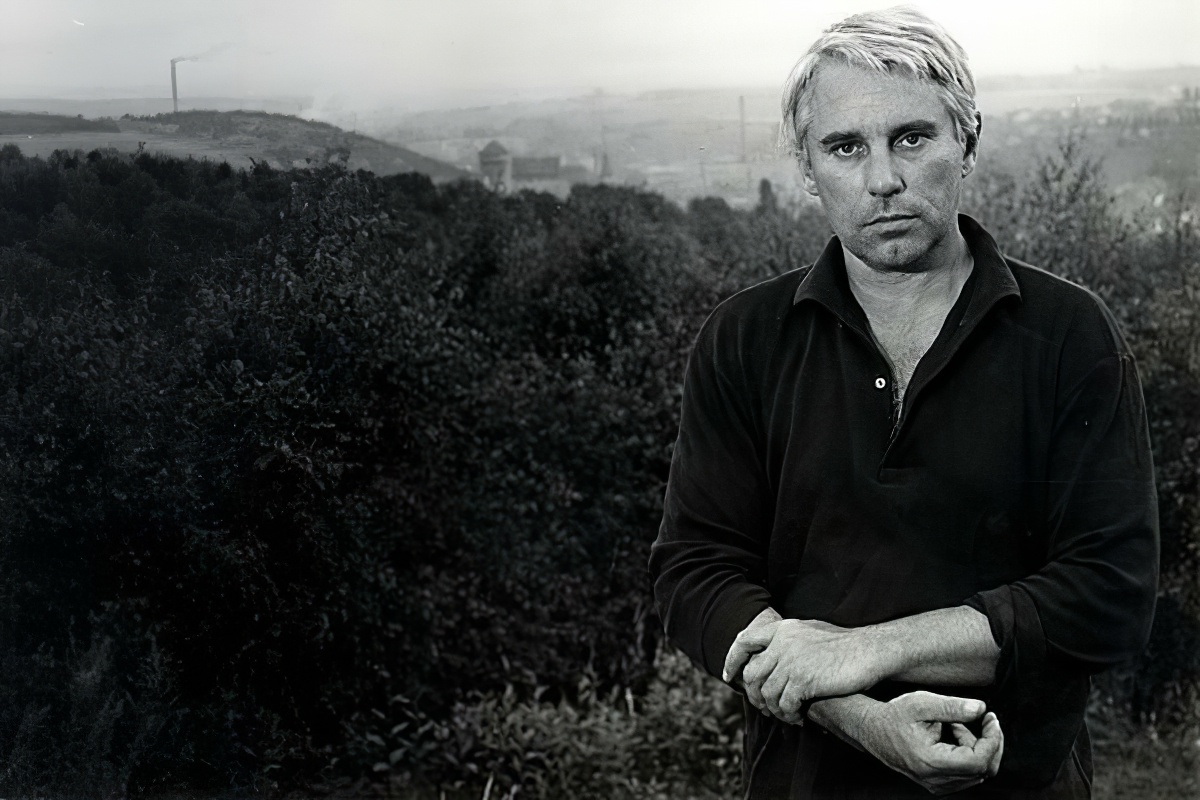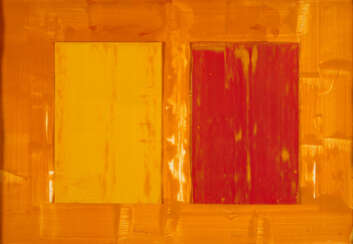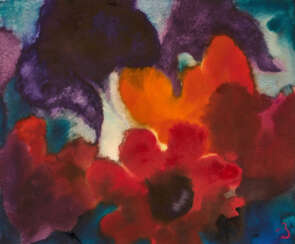
Post War paintings, drawings, watercolours — 1229. Auction ONLINE ONLY | German Post War

Ulrich Erben is a German painter. From 1980 to 2005, he was a Professor of Painting at the Kunstakademie Münster (University of Fine Arts Münster). He is known as a master of the color field style of abstract painting, closely related to abstract expressionism, in which he creates tension between a defined surface structure, his own method of applying paint to a canvas, and the relationship of various shades of white or color to each other in their placement as part of a composition on the flat plane of a canvas. In 1986 and 2008, he was awarded the Konrad-von-Soest Prize for Visual Arts by the Landschaftsverband Westfalen-Lippe (Landscape Society Westphalia-Lippe).

Markus Lüpertz is a German painter, sculptor, graphic artist, and writer. He also publishes a magazine, and plays jazz piano. He is one of the best-known German contemporary artists. His subjects are characterized by suggestive power and archaic monumentality. Lüpertz insists on capturing the object of representation with an archetypal statement of his existence. His art work is associated to neo-expressionism. Known for his eccentricity, German press has stylized him as a «painter prince».

Hann Trier was a German abstract expressionist watercolourist and graphic artist. Hann Trier is best known for his giant ceiling paintings in the Charlottenburg Palace. He was the older brother of the art historian Eduard Trier (1920-2009).

Emil Schumacher was a German painter. He was an important representative of abstract expressionism in post-war Germany.
In 2009 the Kunstquartier Hagen was inaugurated combining the Karl Ernst Osthaus-Museum Hagen as well as the newly built Emil Schumacher Museum in one Museum complex.

Erwin Bechtold is a German abstract painter and sculptor. He spent some time in Paris, where he had the opportunity to work with Fernand Léger.
Erwin Bechtold was the founder of the artist's group Ibiza 59, whose members sought to create art free of subjective expression. Bechtold's paintings from this period were characterised by minimal geometric forms and the use of a monochromatic colour palette.
Later in his career, Bechtold began experimenting with sculpture, creating large-scale works that explored the relationship between form and space.

Horst Janssen was a German graphic artist, printmaker, poster and illustrator. He created many drawings, etchings, woodcuts, lithographs, and woodcuts.
There is a museum dedicated to his legacy in Horst Janssen's hometown of Oldenburg. His works are represented internationally in major museums.

Karl Fred Dahmen is a German artist, one of the most important representatives of German post-war art and the Informel movement. In 1967 he took up the post of Professor of Fine Arts at the Munich Academy.
He painted expressive abstract pictures with a tectonic structure, and since the mid-1950s, relief paintings and collages on the damage to the local landscape caused by open-pit mining. Later in Dahmen's oeuvre, glazed object boxes appear, recounting the impressions of his daily working life.

Erwin Bechtold is a German abstract painter and sculptor. He spent some time in Paris, where he had the opportunity to work with Fernand Léger.
Erwin Bechtold was the founder of the artist's group Ibiza 59, whose members sought to create art free of subjective expression. Bechtold's paintings from this period were characterised by minimal geometric forms and the use of a monochromatic colour palette.
Later in his career, Bechtold began experimenting with sculpture, creating large-scale works that explored the relationship between form and space.

Erwin Bechtold is a German abstract painter and sculptor. He spent some time in Paris, where he had the opportunity to work with Fernand Léger.
Erwin Bechtold was the founder of the artist's group Ibiza 59, whose members sought to create art free of subjective expression. Bechtold's paintings from this period were characterised by minimal geometric forms and the use of a monochromatic colour palette.
Later in his career, Bechtold began experimenting with sculpture, creating large-scale works that explored the relationship between form and space.

Klaus Fußmann is a contemporary German painter. He studied from 1957 to 1961 at the Folkwang University of the Arts in Essen and from 1962 to 1966 at the Berlin University of the Arts. From 1974 to 2005, he was a professor at the Berlin University of the Arts. His work has won several awards, such as the Villa Romana prize in 1972 and the Art Award of Darmstadt in 1979. Major presentations of his work include exhibitions at the Neue Nationalgalerie in Berlin, 1972; the Mathildenhöhe in Darmstadt, 1982; the Kunsthalle Emden, 1988; the Kunsthalle Bremen, 1992; and the Museum Ostwall in Dortmund, 2003. In 2005 Fußmann completed a monumental ceiling painting in the Mirror Hall of the Museum für Kunst und Gewerbe Hamburg.

Klaus Fußmann is a contemporary German painter. He studied from 1957 to 1961 at the Folkwang University of the Arts in Essen and from 1962 to 1966 at the Berlin University of the Arts. From 1974 to 2005, he was a professor at the Berlin University of the Arts. His work has won several awards, such as the Villa Romana prize in 1972 and the Art Award of Darmstadt in 1979. Major presentations of his work include exhibitions at the Neue Nationalgalerie in Berlin, 1972; the Mathildenhöhe in Darmstadt, 1982; the Kunsthalle Emden, 1988; the Kunsthalle Bremen, 1992; and the Museum Ostwall in Dortmund, 2003. In 2005 Fußmann completed a monumental ceiling painting in the Mirror Hall of the Museum für Kunst und Gewerbe Hamburg.

Klaus Fußmann is a contemporary German painter. He studied from 1957 to 1961 at the Folkwang University of the Arts in Essen and from 1962 to 1966 at the Berlin University of the Arts. From 1974 to 2005, he was a professor at the Berlin University of the Arts. His work has won several awards, such as the Villa Romana prize in 1972 and the Art Award of Darmstadt in 1979. Major presentations of his work include exhibitions at the Neue Nationalgalerie in Berlin, 1972; the Mathildenhöhe in Darmstadt, 1982; the Kunsthalle Emden, 1988; the Kunsthalle Bremen, 1992; and the Museum Ostwall in Dortmund, 2003. In 2005 Fußmann completed a monumental ceiling painting in the Mirror Hall of the Museum für Kunst und Gewerbe Hamburg.

Klaus Fußmann is a contemporary German painter. He studied from 1957 to 1961 at the Folkwang University of the Arts in Essen and from 1962 to 1966 at the Berlin University of the Arts. From 1974 to 2005, he was a professor at the Berlin University of the Arts. His work has won several awards, such as the Villa Romana prize in 1972 and the Art Award of Darmstadt in 1979. Major presentations of his work include exhibitions at the Neue Nationalgalerie in Berlin, 1972; the Mathildenhöhe in Darmstadt, 1982; the Kunsthalle Emden, 1988; the Kunsthalle Bremen, 1992; and the Museum Ostwall in Dortmund, 2003. In 2005 Fußmann completed a monumental ceiling painting in the Mirror Hall of the Museum für Kunst und Gewerbe Hamburg.

Fred Thieler was a German abstract artist known for his colorful, gestural paintings. He was born in Königsberg, Germany, and studied at the Academy of Fine Arts in Königsberg before moving to Berlin in 1945.
Thieler's early work was influenced by the Expressionist and Surrealist movements, but he soon developed his own unique style characterized by bold colors and dynamic brushstrokes. He often used a palette knife to apply paint to the canvas, creating thick, impasto layers that added depth and texture to his works.
Throughout his career, Thieler participated in numerous exhibitions in Germany and internationally, including the Venice Biennale and Documenta in Kassel. He was also a member of the influential German art group "Quadriga," which included artists such as Bernard Schultze, Karl Otto Götz, and Otto Greis.
In addition to painting, Thieler also worked as a graphic designer and a teacher. He was a professor at the Academy of Fine Arts in Berlin from 1965 to 1981, where he had a significant impact on the next generation of German artists.
Thieler's work can be found in many private collections and museums, including the Museum of Modern Art in New York, the Stedelijk Museum in Amsterdam, and the Museum Ludwig in Cologne.

































































